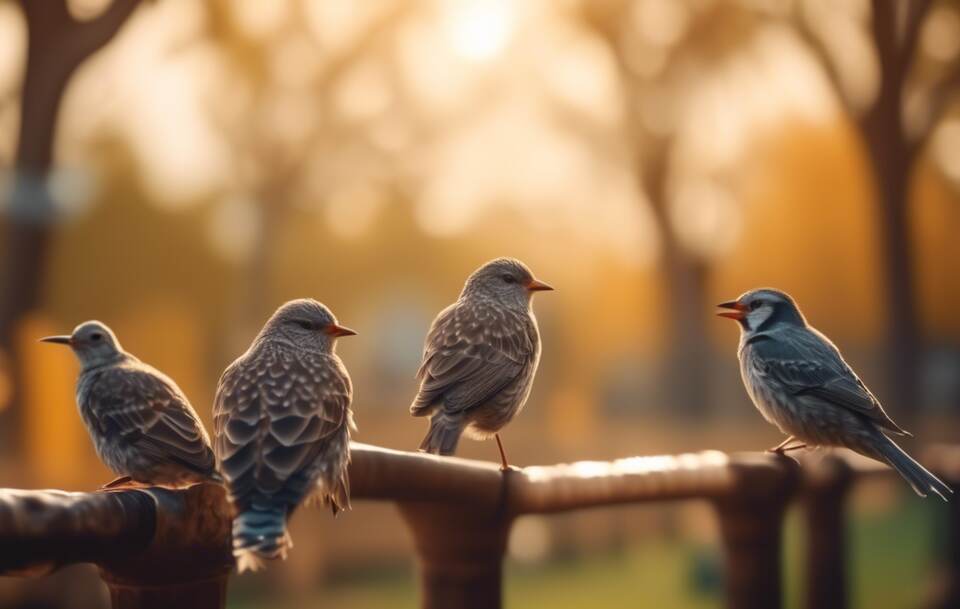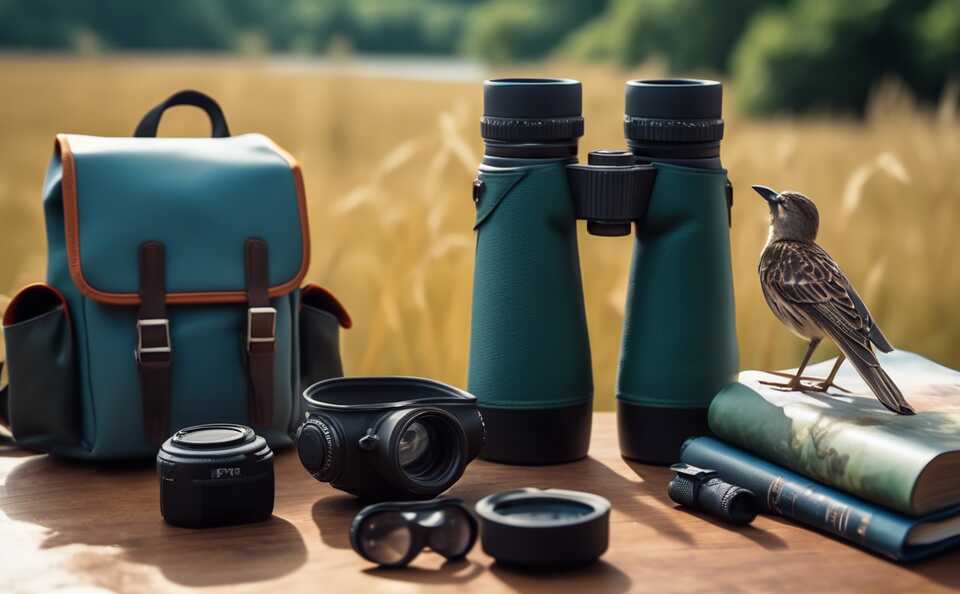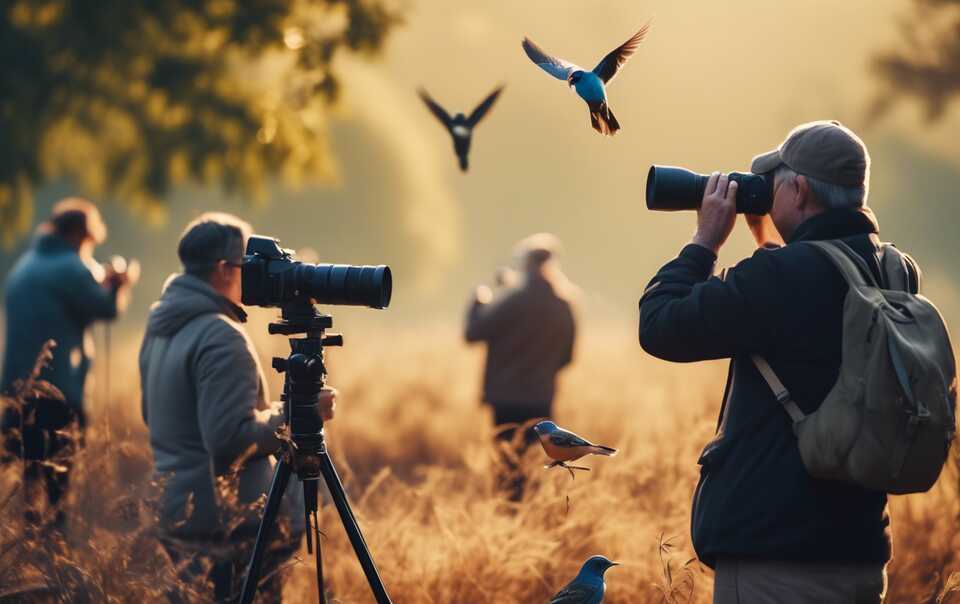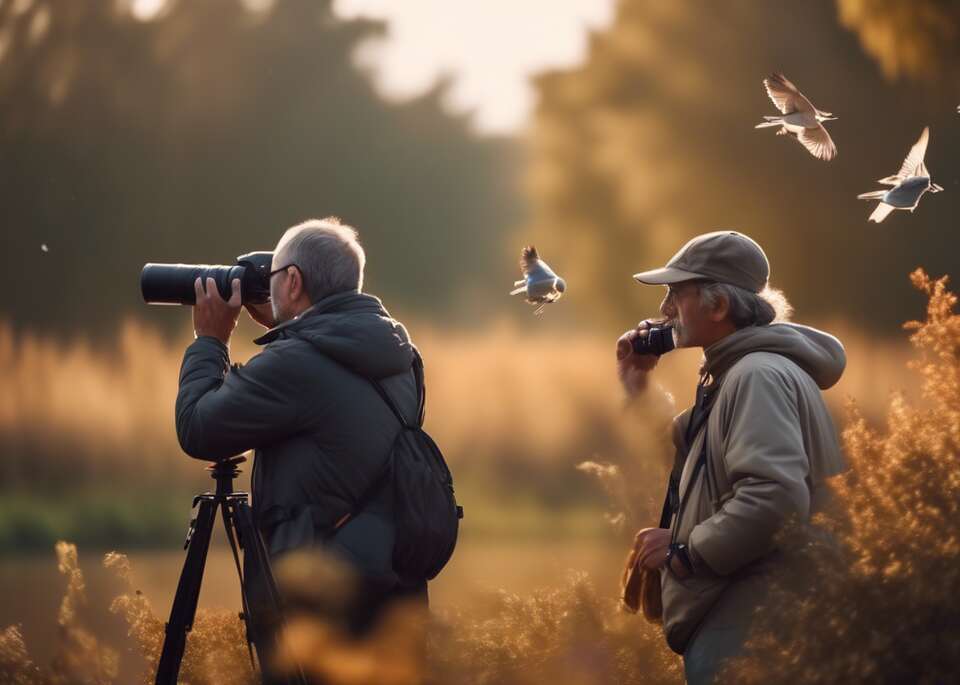Birdwatching is a fascinating and rewarding hobby that allows individuals to connect with nature and observe various bird species in their natural habitats. Whether you are a nature enthusiast, a photography buff, or simply looking for a peaceful outdoor activity, birdwatching can provide a fulfilling experience. This ultimate guide for beginners will equip you with the essential knowledge and tips to embark on your birdwatching journey and make the most out of this wonderful pastime.
Table of Contents
- 1 Birdwatching 101: the Ultimate Guide for Beginners
- 2 Essential Birdwatching Equipment Every Beginner Needs
- 2.1 Binoculars: Your Window to the Birding World
- 2.2 Field Guide: Your Bird Identification Companion
- 2.3 Notebook and Pen: Record Your Birdwatching Adventures
- 2.4 Birdwatching App: Technology meets Nature
- 2.5 Field Clothing: Blend In with Nature
- 2.6 Bird Feeder and Birdseed: Attract Birds to Your Yard
- 2.7 Backpack: Carry Your Essentials with Ease
- 3 Top Birdwatching Destinations Around the World
- 3.1 Costa Rica – A Tropical Paradise for Birdwatchers
- 3.2 The Galapagos Islands – Where Evolution Comes to Life
- 3.3 Maasai Mara National Reserve – Birdwatching on Safari
- 3.4 The Pantanal – South America’s Birdwatching Gem
- 3.5 Kruger National Park – Birding in the African Bush
- 3.6 The Everglades – Birdwatching in America’s Wetland
- 3.7 Borneo – Exploring Southeast Asia’s Biodiversity
- 4 Bird Identification Tips for Beginners
- 5 Birdwatching Etiquette: Respecting Nature and Wildlife
- 6 Conclusion
- 7 Author
Birdwatching 101: the Ultimate Guide for Beginners
Getting Started with Birdwatching
To kick off your birdwatching adventure, it is essential to start with the right equipment. Invest in a pair of binoculars with good magnification and clarity to observe birds from a distance. Additionally, a field guide specific to birds in your region will help you identify different species. Comfortable clothing and sturdy footwear are also vital for long hours of exploration in nature. Keeping a bird checklist handy allows you to track sightings, while jotting down notes in a journal captures memorable observations and experiences during your wildlife adventures.
Choosing the Right Location
Selecting the right location is crucial for a successful birdwatching experience. Start by researching local birding hotspots such as parks, nature reserves, or wildlife sanctuaries. These areas are likely to have a diverse range of bird species for you to observe. Joining local birdwatching groups or clubs can also provide valuable insights into the best locations in your area.
Developing Observation Skills
Observation is key in birdwatching. Learn to pay attention to small details such as plumage patterns, behavior, and habitat preferences to identify different bird species. Practice patience and avoid making sudden movements or loud noises that may scare away the birds. Over time, your observation skills will improve, allowing you to spot and recognize birds more efficiently.
Understanding Bird Behavior
Understanding bird behavior is essential for successful birdwatching. Birds exhibit various behaviors such as feeding, nesting, singing and mating rituals, which can provide valuable insights into their lives. Learning about common bird behaviors will not only enhance your birdwatching experience but also deepen your appreciation for these avian creatures.
Recording Your Sightings
Keeping a birdwatching journal or logbook is a great way to track your sightings and monitor your progress. Note down the date, time, location, and species of birds you observe. Take photographs if possible to document your sightings and create lasting memories of your birdwatching adventures.
Respecting Nature and Wildlife
As a birdwatcher, it is important to respect nature and wildlife. Stay on designated trails, avoid disturbing bird habitats, and refrain from feeding or approaching the birds too closely. By practicing responsible birdwatching, you can help protect and preserve the natural environment for future generations to enjoy.
Birdwatching is a fulfilling and enjoyable hobby that provides a unique opportunity to connect with nature and appreciate the beauty of avian life. By following this ultimate guide for beginners, you can start your birdwatching journey on the right foot and experience the wonders of the birding world. So grab your binoculars, head outdoors, and let the adventure begin!

Essential Birdwatching Equipment Every Beginner Needs
Birdwatching is a fascinating hobby that allows you to connect with nature and observe the beauty of various bird species in their natural habitats. As a beginner birdwatcher, having the right equipment is essential to enhance your birdwatching experience. Here is a comprehensive guide to the essential birdwatching equipment that every beginner needs.
Binoculars: Your Window to the Birding World
Binoculars are the most crucial tool for birdwatching. Opt for a pair with good magnification (8x to 10x) and a wide field of view. This will help you observe birds clearly and locate them easily in the wild. Look for compact and lightweight binoculars for ease of use during long birdwatching sessions.
Field Guide: Your Bird Identification Companion
A field guide is a handy resource that provides information on different bird species, their behaviors, habitats, and physical characteristics. Choose a field guide specific to your region to accurately identify the birds you encounter. Make sure it includes illustrations or photos for quick reference in the field.
Notebook and Pen: Record Your Birdwatching Adventures
Keeping a birdwatching journal and checklist is a great way to document your sightings, jot down observations, and track your progress as a birder. Note down the date, time, location, and any distinctive features of the birds you observe. This will help you enhance your bird identification skills over time.
Birdwatching App: Technology meets Nature
Birdwatching apps like eBird, Audubon Bird Guide App, Merlin Bird ID by Cornell Lab, and Birda are valuable resources for birders of all levels. These apps provide bird calls, identification tips, maps of birding hotspots, and real-time information on bird sightings in your area. Download a reputable birdwatching app to enhance your birdwatching experience and learn more about the birds around you.
Field Clothing: Blend In with Nature
Wearing the right clothing is essential for a comfortable and successful birdwatching expedition. Opt for neutral-colored, lightweight, and breathable clothing to blend in with your surroundings and avoid startling the birds. Consider clothing with multiple pockets to carry essentials like your field guide and notebook.
Bird Feeder and Birdseed: Attract Birds to Your Yard
Setting up a bird feeder in your backyard is a great way to attract a variety of bird species for observation. Choose a feeder that is easy to clean and fill, and stock up on high-quality birdseed to entice birds to visit regularly. Place the feeder in a visible yet safe spot for optimal birdwatching opportunities.
Backpack: Carry Your Essentials with Ease
A durable and comfortable backpack is essential for carrying all your birdwatching gear, snacks, water, and any other essentials. Look for a backpack with multiple compartments, padded straps, and adjustable features for long hours of birdwatching in the field.
Equipping yourself with the essential birdwatching gear mentioned above will set you on the right path to becoming a successful and enthusiastic birder. Remember to respect nature, follow birdwatching ethics, and enjoy the beauty of the avian world around you. Happy birdwatching!

Top Birdwatching Destinations Around the World
When it comes to birdwatching, there are numerous fantastic destinations around the world that offer unique experiences for enthusiasts. From lush rainforests to expansive wetlands, here are some of the most captivating birdwatching destinations you should consider visiting:
Costa Rica – A Tropical Paradise for Birdwatchers
Costa Rica is a birdwatcher’s paradise, boasting a diverse range of habitats that are home to over 900 bird species. Whether you explore the cloud forests of Monteverde, the coastal wetlands of Tortuguero, or the tropical rainforests of Corcovado National Park, you’ll have the opportunity to spot colorful toucans, hummingbirds, and the resplendent quetzal.
The Galapagos Islands – Where Evolution Comes to Life
The Galapagos Islands, located off the coast of Ecuador, offer a truly unique birdwatching experience. As the place that inspired Charles Darwin’s theory of evolution, the islands are home to an array of endemic bird species, including the iconic blue-footed booby, waved albatross, and Galapagos penguin.
Maasai Mara National Reserve – Birdwatching on Safari
While the Maasai Mara in Kenya is best known for its spectacular wildlife, it is also a fantastic destination for birdwatching. During the annual migration, you can witness thousands of birds, including colorful bee-eaters, eagles, and vultures, congregating around the Mara River.
The Pantanal – South America’s Birdwatching Gem
As the world’s largest tropical wetland area, the Pantanal in Brazil is a haven for birdwatchers. With over 650 bird species, including the iconic Hyacinth Macaw and Toco Toucan, the Pantanal offers exceptional opportunities for spotting both waterfowl and forest-dwelling birds.
Kruger National Park – Birding in the African Bush
South Africa’s Kruger National Park is not only renowned for its big game but also for its birdlife. With nearly 500 bird species recorded within the park, including the majestic Martial Eagle and vibrant Lilac-breasted Roller, Kruger offers a rich birdwatching experience amidst stunning savannah landscapes.
The Everglades – Birdwatching in America’s Wetland
The Everglades National Park in Florida is a mecca for birdwatchers, with its vast expanse of wetlands supporting a diverse avian population. From the elusive Snail Kite to the striking Roseate Spoonbill, the Everglades are home to a plethora of bird species that can be spotted on airboat tours or scenic walks.
Borneo – Exploring Southeast Asia’s Biodiversity
Borneo, the third-largest island in the world, is a treasure trove of biodiversity and a prime destination for birdwatching. With endemic species like the Bornean Bristlehead and Rhinoceros Hornbill, as well as a variety of colorful kingfishers and broadbills, Borneo offers a one-of-a-kind birding adventure in the heart of Southeast Asia.
Whether you’re a seasoned birder or just starting out, these top birdwatching destinations around the world are sure to provide unforgettable experiences and countless opportunities to connect with the natural world.

Bird Identification Tips for Beginners
Bird identification is a crucial skill for birdwatching enthusiasts, especially beginners looking to delve into the fascinating world of avian observation. Successfully identifying birds in the wild enhances the overall birdwatching experience and enables enthusiasts to appreciate the diverse species they encounter. Whether you are exploring your backyard, local park, or embarking on a birdwatching trip, these practical tips will help you become more proficient at identifying birds.
Understanding Bird Field Marks
When attempting to identify a bird, it is essential to pay attention to its field marks. These include various characteristics such as size, shape, color patterns, bill shape, wing shape, and tail length. By observing and noting down these distinctive features, you can narrow down the potential bird species significantly.
Utilizing Field Guides and Apps
Field guides are invaluable resources for birdwatchers. Invest in a good quality field guide that is specific to your region or the areas where you plan to observe birds. These guides contain illustrations, range maps, and detailed descriptions of different bird species, aiding in accurate identification. Additionally, there are several bird identification apps available for smartphones that can assist you in identifying birds on the go.
Paying Attention to Habitat and Behavior
Take note of the habitat where you spot a particular bird species as different birds prefer distinct habitats. Some birds are commonly found near water bodies, while others thrive in forests or open fields. Furthermore, observe the bird’s behavior, such as its feeding habits, flight patterns, and vocalizations, as these can provide valuable clues for identification.
Memorizing Common Species
Start by familiarizing yourself with the most common bird species in your area. Focus on recognizing backyard birds like sparrows, finches, robins, and cardinals before moving on to more challenging species. Practice observing and identifying these common birds to build a solid foundation for birdwatching.
Joining Birdwatching Groups or Workshops
Engaging with experienced birdwatchers through local birdwatching groups or workshops is an excellent way to enhance your bird identification skills. These groups often organize birdwatching outings, provide mentorship, and offer opportunities to learn from seasoned birdwatchers. Sharing knowledge and experiences with fellow enthusiasts can significantly boost your birdwatching proficiency.
Using Mnemonics for Bird Songs
Bird songs and calls are distinctive and can aid in bird identification. Learning mnemonics—short phrases that mimic bird vocalizations—can help you remember and differentiate between various bird songs. Practice listening to recordings of bird songs and associating them with mnemonics to improve your ability to identify birds by sound.
Practicing Patience and Persistence
Birdwatching is a skill that develops over time with practice and patience. It is essential to be persistent and observant while honing your bird identification abilities. Remember that making mistakes is part of the learning process, and each bird encounter is an opportunity to enhance your identification skills.
Mastering bird identification is an exciting journey that enriches your birdwatching experiences. By incorporating these tips into your birdwatching routine, you will gradually become more adept at recognizing and appreciating the diverse bird species around you. Happy birdwatching!

Birdwatching Etiquette: Respecting Nature and Wildlife
The beauty of birdwatching lies not only in the thrill of spotting different bird species but also in the opportunity to connect with nature and wildlife. As birdwatchers, it is crucial to be mindful of our impact on the environment and the creatures we are observing. By following proper birdwatching etiquette, we can ensure that we respect nature and wildlife while enjoying this fascinating hobby.
Understanding the Environment
Before setting out on a birdwatching excursion, it is essential to familiarize yourself with the environment you will be exploring. Research the area to learn about the types of birds you are likely to encounter, the best times for birdwatching, and any specific rules or regulations that apply. By understanding the environment, you can better appreciate the significance of preserving and protecting it.
Respecting Wildlife
When observing birds in their natural habitat, it is vital to respect their space and minimize disturbances. Avoid getting too close to nesting sites or feeding areas, as this can cause stress to the birds and disrupt their natural behaviors. Use binoculars or a spotting scope to view birds from a distance, allowing them to carry on with their activities undisturbed.
Litter-Free Birdwatching
One of the fundamental principles of birdwatching etiquette is to leave no trace. Make sure to dispose of any trash properly and avoid littering in the areas you visit. This not only helps in preserving the beauty of nature but also ensures the safety of wildlife who may mistake litter for food. Remember, the goal is to observe and appreciate birds without leaving a negative impact on their habitat.
Code of Conduct
As a responsible birdwatcher, it is essential to follow a code of conduct that prioritizes the well-being of birds and their environment. This includes refraining from using recordings or playback to attract birds, as this can disrupt their natural behaviors and cause unnecessary stress. Additionally, avoid trespassing on private property and always abide by posted regulations in protected areas.
Educating Others
Part of being a mindful birdwatcher is sharing your knowledge and passion for birds with others. Encourage fellow birdwatchers to practice ethical behavior and respect for wildlife. By educating others about the importance of birdwatching etiquette, you can help foster a community of responsible nature enthusiasts dedicated to the conservation of birds and their habitats.
Birdwatching etiquette is essential for maintaining a harmonious relationship with nature and wildlife. By understanding the environment, respecting wildlife, keeping birdwatching areas litter-free, following a code of conduct, and educating others, we can enjoy the beauty of birdwatching while ensuring the well-being of birds and their habitats. Remember, the joy of birdwatching lies not just in the sightings but in the profound connection we form with the natural world around us.
Conclusion
Birdwatching is a rewarding and fascinating hobby that allows individuals to connect with nature, observe diverse bird species, and immerse themselves in the beauty of the natural world. By following this comprehensive guide for beginners, you can embark on your birdwatching journey with confidence and enthusiasm.
Equipped with the essential birdwatching gear, including binoculars, field guides, and a notebook, you will be well-prepared to spot and identify different bird species in various habitats. Remember to practice patience and attentiveness while birdwatching, as these qualities are crucial for successful bird identification.
Exploring top birdwatching destinations around the world offers you the opportunity to witness an incredible array of bird species in their natural habitats. Whether you choose to visit renowned birdwatching hotspots like the Galapagos Islands, the Amazon rainforest, or the Serengeti National Park, each location offers a unique birdwatching experience that will leave you in awe of nature’s wonders.
When it comes to identifying birds, beginners can rely on simple yet effective tips such as observing size, shape, coloration, behavior, and habitat preferences. By familiarizing yourself with common bird species in your area and understanding their distinct characteristics, you will gradually develop the skills needed to identify birds with ease.
Additionally, practicing birdwatching etiquette is essential for maintaining a respectful and sustainable approach to observing birds in the wild. By following guidelines such as respecting wildlife habitats, keeping a safe distance from birds, and minimizing disturbances, you can ensure that your birdwatching activities have minimal impact on the environment and the creatures that inhabit it.
By immersing yourself in the world of birdwatching, you will not only enhance your knowledge of avian species but also cultivate a deeper appreciation for the beauty and diversity of the natural world. Whether you are a seasoned birder or a novice enthusiast, birdwatching offers a fulfilling way to connect with nature, unwind from the stresses of daily life, and foster a sense of wonder and curiosity about the world around you.
As you continue to refine your birdwatching skills and explore new birdwatching destinations, remember to approach each birdwatching experience with enthusiasm, respect, and a spirit of awe and wonder. By following the tips and guidelines outlined in this ultimate guide for beginners, you can embark on an enriching birdwatching journey that will bring you closer to the fascinating world of birds and the wonders of nature. Happy birdwatching!



